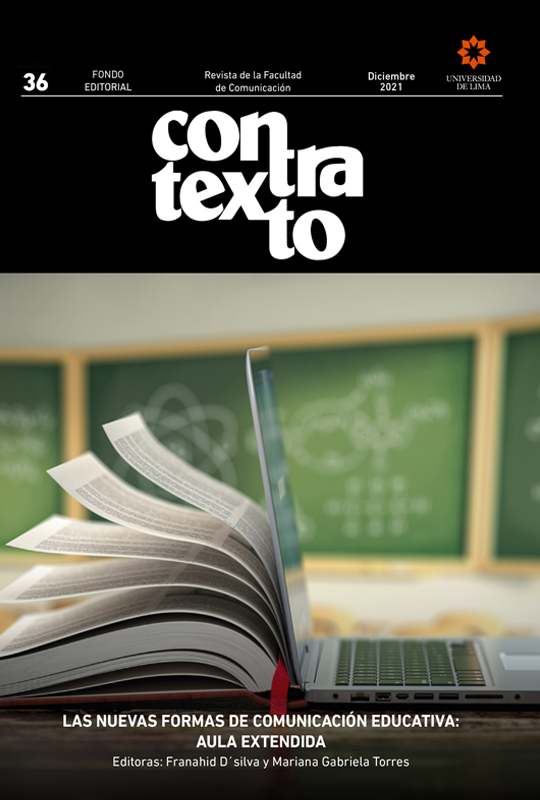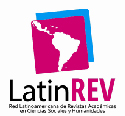Juegos transmedia “Yo amo leer”: experiencias inmersivas, espacios de afinidad, aprendizaje conectado y creación de vínculo con la comunidad
DOI:
https://doi.org/10.26439/contratexto2021.n036.5237Palabras clave:
experiencias inmersivas, juegos transmediales, aprendizaje conectado, innovación educativa, fomento a la lecturaResumen
Este artículo explora las experiencias y los aprendizajes de alumnos universitarios al participar en diferentes roles (jugadores, actores y staff) en juegos transmedia. Se realizó un caso de estudio llevado a cabo en la universidad que analiza nueve de los once juegos “Yo amo leer” llevados a cabo del 2014 al 2019 para fomentar la lectura. La participación en dichos eventos ha sido aproximadamente de 1048 alumnos universitarios. Los resultados y hallazgos indican que estos juegos son experiencias inmersivas que generan disposición a la lectura y aprendizajes diversos, despiertan interés y proporcionan beneficios a la comunidad de la universidad. Se concluye que generan un espacio de afinidad intramuros y constituyen una estrategia efectiva para promover el aprendizaje conectado.
Descargas
Referencias
Adams, E. (2014). Fundamentals of Game Design (3.a ed.). New Riders.
Bonsignore, E., Hansen, D., Kraus, K., Visconti, A., Ahn, J., y Druin, A. (junio, 2013). Playing for Real: Designing Alternate Reality Games for Teenagers in Learning Contexts. En IDC ‘13: Proceedings of the 12th International Conference on Interaction Design and Children (pp. 237-246). https://doi.org/10.1145/2485760.2485788
Bonsignore, E., Hansen, D., Kraus, K., Visconti, A., y Fraistat, A. (octubre, 2016). Roles People Play: Key Roles Designed to Promote Participation and Learning in Alternate Reality Games. En CHI PLAY ‘16: Proceedings of the 2016 Annual Symposium on Computer-Human Interaction in Play (pp. 78-90). https://doi.org/10.1145/2967934.2968108
Boyd, D. (2014). It’s Complicated: The Social Lives of Networked Teens. Yale University Press Chess, S., y Booth, P. (2014). Lessons Down a Rabbit Hole: Alternate Reality Gaming in the Classroom. New Media & Society, 16(6), 1002-1017. https://doi.org/10.1177/1461444813497554
Connolly, T. M., Stansfield, M., y Hainey, T. (2011). An Alternate Reality Game for Language Learning: ARGuing for Multilingual Motivation. Computers & Education, 57(1), 1389-1415. https://doi.org/10.1016/j.compedu.2011.01.009
Donald, J. W. (2008). The Blood in the Stacks ARG: Immersive Marketing Meets Library New Student Orientation. En A. Harris, y S. E. Rice (Eds.), Gaming in Academic Libraries: Collections Marketing and Information Literacy (pp. 189-211). American Library Association. https://goo.gl/8gPvsX
Dondlinger, M. J., y McLeod, J. K. (2015). Solving Real World Problems with Alternate Reality Gaming: Student Experiences in the Global Village Playground Capstone Course Design. Interdisciplinary Journal of Problem-Based Learning, 9(2). https://doi.org/10.7771/1541-5015.1488
Gambarato, R. (2013). Transmedia Project Design: Theoretical and Analytical Considerations. Baltic Screen Media Review, 1(11), 80-100. https://doi.org/10.1515/bsmr-2015-0006
Gee, J., y Hayes, E. (2012). Nurturing Affinity Spaces and Game-Based Learning. En C. Steinkuehler, K. Squire y S. Barab (Eds.), Games, Learning, and Society. Learning and Meaning in the Digital Age (pp. 129-153). Cambridge University Press. https://doi.org/10.1017/CBO9781139031127.015
Gilliam, M., Jagoda, P., Fabiyi, C., Lyman, P., Wilson, C., Hill, B., y Bouris, A. (2017). Alternate Reality Games as an Informal Learning Tool for Generating STEM Engagement among Underrepresented Youth: A Qualitative Evaluation of the Source. Journal of Science Education and Technology, 26(3), 295-308. https://dl.acm.org/doi/abs/10.1145/2526968.2526973
Hakulinen, L. (noviembre, 2013). Alternative Reality Games for Computer Science Education. En Koli Calling ‘13: Proceedings of the 13th Koli Calling International Conference on Computing Education Research (pp. 43-50). https://doi.org/10.1145/2526968.2526973
Hunicke, R., LeBlanc, M., y Zubek, R. (2004). MDA: A Formal Approach to Game Design and Game Research. Proceedings of the AAAI Workshop on Challenges in Game AI, 4(1). http://goo.gl/jYFt4W
Ito, M., Baumer, S., Bittanti, M., Boyd, D., Cody, R., Herr-Stephenson, B., Horst, H. A., Lange, P. J., Mahendran, D., Martínez, K. Z., Pascoe, C. J., Perkel, D., Robinson, L., Sims, Ch., y Tripp, L. (2010). Hanging Out, Messing Around and Geeking Out: Kids Learning and Living in New Media. The MIT Press.
Ito, M., Gutiérrez, K., Livingstone, S., Penuel, B., Rhodes, J., Salen, K., Schor, J., Sefton-Green, J., y Watkins, S. C. (2013). Connected Learning: An Agenda for Research and Design. Digital Media and Learning Research Hub.
Ito, M., Martin, C., Pfister, R. C., Rafalow, M. H., Salen, K., y Wortman, A. (2018). Affinity Online: How Connection and Shared Interest Fuel Learning (vol. 2). NYU Press.
Jenkins, H. (2006). Convergence Culture. Where Old and New Media Collide. New York University.
Jenkins, H. (21 de junio del 2010). Transmedia Education: The 7 Principles Revisited. Confessions of an ACA-FAN. http://henryjenkins.org/blog/2010/06/transmedia_education_the_7_pri.html
Jerrett, A., Bothma, T., y Beer, K. de. (2017). Exercising Library and Information Literacies Through Alternate Reality Gaming. Aslib Journal of Information Management, 69(2), 230-254. https://doi.org/10.1108/AJIM-11-2016-0185
Johnston, J. D., Massey, A. P., y Marker-Hoffman, R. L. (2012). Using an Alternative Reality Game to Increase Physical Activity and Decrease Obesity Risk of College Students. Journal of Diabetes Science and Technology, 6(4), 828-838.
Keating, E., y Sunakawa, C. (2010). Participation Cues: Coordinating Activity and Collaboration in Complex Online Gaming Worlds. Language in Society, 39(3), 331-356. https://doi.org/10.1017/S0047404510000217
Kinio, A. E., Dufresne, L., Brandys, T., y Jetty, P. (2019). Break Out of the Classroom: the Use of Escape Rooms as an Alternative Teaching Strategy in Surgical Education. Journal of Surgical Education, 76(1), 134-139. https://doi.org/10.1016/j.jsurg.2018.06.030
López-Pernas, S., Gordillo, A., Barra, E., y Quemada, J. (2019). Examining the Use of an Educational Escape Room for Teaching Programming in a Higher Education Setting. IEEE Access, 7, 31723-31737. https://doi.org/10.1109/ACCESS.2019.2902976
Lugo Rodríguez, N. (2016). Diseño de narrativas transmedia para la transalfabetización [Tesis de doctorado, Universitat Pompeu Fabra]. http://hdl.handle.net/10803/396131
Lugo Rodríguez, N. (s. f.). El viaje de las narrativas transmedia al diseño de experiencias de aprendizaje transmedia [manuscrito inédito]. Universidad Iberoamericana.
Lugo Rodríguez, N., y Melón Jareda, M. E. (2016). Juegos de realidad alternativa para la educación cívica. Elementos de diseño: narrativa, juego y discurso. Commons, 6(2), 177-202. https://doi.org/10.25267/COMMONS.2016.v5.i2.08
Morrell, B. L., y Ball, H. M. (2020). Can You Escape Nursing School? Educational Escape Room in Nursing Education. Nursing Education Perspectives, 41(3), 197-198. https://doi.org/10.1097/01.NEP.0000000000000441
Niemeyer, G., Garcia, A., y Naima, R. (octubre, 2009). Black Cloud: Patterns Towards da Future. En MM ‘09: Proceedings of the 17th ACM international conference on Multimedia (pp. 1073-1082). ACM. https://doi.org/10.1145/1631272.1631514
Piatt, K. (2009). Using Alternate Reality Games to Support First Year Induction with ELGG. Campus-Wide Information Systems, 26(4), 313-322. https://doi.org/10.1108/10650740910984646
Piñeiro, T., y Costa, C. (2015). ARG (juegos de realidad alternativa). Contribuciones, limitaciones y potencialidades para la docencia universitaria. Comunicar, 44, 141-148. http://dx.doi.org/10.3916/C44-2015-15
Pratten, R. (2011). Getting Started in Transmedia Storytelling: A Practical Guide for Beginners. CreateSpace.
Scolari, C. A. (2013). Narrativas transmedia. Cuando todos los medios cuentan. Deusto.
Scolari, C. A. (Ed.). (2018). Teens, Media and Collaborative Cultures: Exploiting Teens’ Transmedia Skills in the Classroom. Universitat Pompeu Fabra. http://hdl.handle.net/10230/34245
Thorne, S. L., Black, R. W., y Sykes, J. M. (2009). Second Language Use, Socialization, and Learning in Internet Interest Communities and Online Gaming. The ModernLanguage Journal, 93(s1), 802-821. https://doi.org/10.1111/j.1540-4781.2009.00974.x
Whitton, N., Jones, R., Wilson, S., y Whitton, P. (2014). Alternate Reality Games as Learning Environments for Student Induction. Interactive Learning Environments, 22(3), 243-252. https://doi.org/10.1080/10494820.2011.641683
Descargas
Publicado
Número
Sección
Licencia
Todos los trabajos publicados están sujetos a una licencia CC BY 4.0 Creative Commons (actualizado el 1 de marzo de 2021).
El contenido de la revista se puede compartir en cualquier material o formato. Asimismo, se puede adaptar, contribuir y transformar. Ambas posibilidades sólo están permitidas en la medida en que cumplan las siguientes condiciones:
- Atribución: Se debe otorgar crédito donde sea debido, proporcionar un enlace a la licencia e indicar los cambios en caso se realice alguno. Esto debe hacerse de la manera que se considere apropiada, sin sugerir que el licenciante lo promueva a usted o su uso del material.
Derechos de propiedad
Los derechos patrimoniales de Contratexto se publican bajo una licencia Creative Commons BY 4.0, lo que permite a los autores mantener los derechos patrimoniales de su obra sin restricciones.
Si un trabajo publicado en Contratexto fuera copiado, distribuido, difundido o cualquier otra actividad contemplada en la licencia antes mencionada, se deberá mencionar de manera visible y expresa al autor o autores y a la revista.
Auto-archivo
Esta revista permite y anima a los autores/as a publicar artículos enviados a la revista en sus sitios web personales o en depósitos institucionales, tanto antes como después de su publicación en esta revista, siempre y cuando proporcionen información bibliográfica que acredite, si procede, su publicación en ella.


















